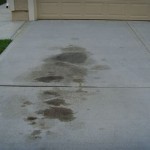How To Re-Concrete A Garage Floor
A deteriorating concrete garage floor can be an eyesore and a safety hazard. Cracks, spalling, and uneven surfaces not only detract from the appearance of your garage but can also pose tripping risks and make it difficult to store items securely. Re-concreting offers a durable, long-lasting solution to these problems, providing a smooth, level surface capable of withstanding heavy loads and regular wear and tear.
1. Preparation is Key
Proper preparation is crucial for a successful re-concreting project. This involves a thorough assessment of the existing concrete slab to determine the extent of the damage and identify any underlying issues that need to be addressed. Begin by cleaning the existing floor thoroughly. Remove any loose debris, oil stains, or other contaminants using a stiff broom, scraper, and degreaser. A pressure washer can be highly effective in removing stubborn dirt and grime. Once the surface is clean, closely inspect the concrete for cracks, scaling, or spalling. Minor cracks can often be repaired with concrete patching compound, while more extensive damage may require removal and replacement of sections of the slab.
Addressing moisture issues is also essential. If the existing concrete shows signs of moisture damage, identifying and rectifying the source of the problem is critical before proceeding. This might involve improving drainage around the garage perimeter, sealing cracks in the foundation walls, or installing a vapor barrier beneath the new concrete slab.
2. Demolition and Removal (If Necessary)
If the existing concrete is severely damaged or if significant leveling is required, complete removal may be necessary. This can be a labor-intensive process, often requiring specialized equipment like a jackhammer or concrete saw. Safety precautions, including wearing appropriate protective gear such as safety glasses, gloves, and dust masks, are paramount during this phase. If asbestos is suspected in the existing concrete, professional abatement is necessary. Disposal of the old concrete should be done responsibly, often requiring a dumpster rental or coordination with a waste removal service. Local regulations regarding concrete disposal should be followed carefully.
For less severe damage, scarifying the existing concrete surface can be an effective alternative to complete removal. Scarifying involves using a specialized machine to roughen the surface, creating a better bonding surface for the new concrete overlay. This method can save time and reduce the amount of debris generated compared to full removal.
3. Forming and Reinforcement
Once the existing concrete has been prepared or removed, the next step is to build forms to contain the new concrete. Forms are typically constructed from wood or metal and should be level and securely braced to prevent movement during the pouring process. The height of the forms will determine the thickness of the new slab. A minimum thickness of 4 inches is generally recommended for garage floors, with thicker slabs being necessary for heavier loads.
Reinforcement is essential for adding strength and preventing cracking in the new concrete. This typically involves placing a layer of wire mesh or rebar within the forms before pouring the concrete. The reinforcement should be supported slightly above the ground to ensure it is embedded within the concrete slab. For areas subject to heavy loads or frequent vehicle traffic, fiber-reinforced concrete can be a cost-effective alternative to traditional reinforcement methods.
Expansion joints are also important to accommodate the natural expansion and contraction of the concrete due to temperature changes. These joints are typically created by inserting pre-molded expansion joint material at intervals within the forms. Properly placed expansion joints will help prevent cracking and ensure the long-term integrity of the new concrete slab.
Pouring and Finishing
Once the forms and reinforcement are in place, the concrete can be poured. It is crucial to use the correct concrete mix designed for garage floors, typically a high-strength mix with low water content. The concrete should be poured evenly within the forms and consolidated using a vibrator to eliminate air pockets and ensure a dense, uniform slab. Once poured, the surface is leveled and smoothed using a screed and then finished with a bull float or trowel to achieve the desired texture. A curing compound is often applied after finishing to help the concrete cure properly and prevent cracking.
Curing
Proper curing is crucial for achieving the desired strength and durability of the new concrete slab. This involves keeping the concrete moist for a specific period, typically 7 to 14 days, to allow for complete hydration of the cement. This can be accomplished by covering the concrete with plastic sheeting, spraying it with water regularly, or using a curing compound. Avoiding heavy traffic or placing loads on the new concrete during the curing period is essential to prevent damage.

How To Fix A Concrete Garage Floor Diy Family Handyman

Concrete Garage Floor Repair By Canadian Masonry Experts

Easily Repair Your Pitted Or Spalled Garage Floor All Floors

Garage Floor Resurfacing The Best In Concrete Restoration
Garage Floor Resurfacing 5 Ways To Re A Onfloor
5 Options For Covering Garage Floors

Refinishing Options For Older Concrete Floors

Garage Floor Resurfacing The Best In Concrete Restoration

Concrete Garage Floor Repair By Canadian Masonry Experts

How To Re Your Garage Floor From Winter Damage Guardian Floors
Related Posts








